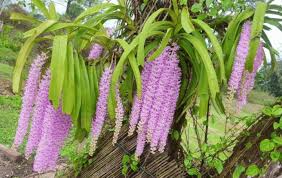Using Rainwater to Water Da Châu Orchids: A Comprehensive Guide
Da Châu orchids (*Rhynchostylis gigantea*), cherished for their stunning flowers and unique growth habits, thrive in a natural environment rich in moisture and humidity. One of the best ways to provide these beautiful orchids with the hydration they need is by using rainwater. This guide explores the benefits of using rainwater for watering Da Châu orchids, practical collection methods, storage, and the best practices for using rainwater effectively.
## 1. Understanding Da Châu Orchids
### 1.1 Botanical Characteristics
Da Châu orchids are native to Southeast Asia and are known for their epiphytic growth habits. They typically grow on trees in their natural habitat, deriving moisture and nutrients from the air and rain. This unique adaptation makes them particularly sensitive to water quality and environmental conditions.
### 1.2 Ideal Growing Conditions
For optimal growth, Da Châu orchids require specific environmental conditions, including:
– **Light**: They prefer bright, indirect light, which mimics the dappled sunlight of their natural forest habitats.
– **Temperature**: Ideal temperatures range from 18°C to 30°C (65°F to 86°F).
– **Humidity**: High humidity levels, ideally between 50% and 80%, are crucial for their health and growth.
### 1.3 Watering Needs
Da Châu orchids thrive on consistent moisture but are also susceptible to root rot if overwatered. Rainwater, with its natural pH and mineral content, is often the best choice for maintaining the right balance.
## 2. Benefits of Using Rainwater for Da Châu Orchids
### 2.1 Purity and Quality
Rainwater is typically cleaner than tap water, which may contain chlorine, fluoride, and other chemicals that can harm sensitive orchid roots. Since rainwater is naturally soft, it lacks the minerals that hard tap water may introduce, making it gentler on orchids.
### 2.2 pH Levels
Rainwater usually has a neutral to slightly acidic pH (around 6.0 to 6.5), which is ideal for Da Châu orchids. This pH level supports nutrient absorption and promotes healthy root development.
### 2.3 Cost-Effectiveness
Collecting rainwater reduces reliance on municipal water sources, leading to lower water bills and a more sustainable approach to gardening.
### 2.4 Environmental Benefits
Using rainwater contributes to environmental sustainability by reducing runoff and conserving water resources. It also minimizes the demand for chemical treatments associated with tap water.
## 3. Collecting Rainwater
### 3.1 Choosing a Collection System
To effectively collect rainwater for your orchids, you need a suitable system. Here are some common methods:
– **Rain Barrels**: Installing rain barrels under downspouts is a popular method. Ensure the barrels are made of food-grade materials and are covered to prevent debris and pests from contaminating the water.
– **Buckets**: Simple buckets placed in open areas can also collect rainwater. Ensure they are clean and free of contaminants.
– **Gutters and Drains**: Utilizing gutters to channel rainwater into a collection system can maximize your harvest.
### 3.2 Setting Up Your Collection System
1. **Location**: Position your rain collection system in a place that receives maximum rainfall, ideally near roof downspouts.
2. **Clean Gutters**: Ensure gutters are free from debris to allow for effective water flow.
3. **Install Filters**: Consider adding screens or filters to keep leaves, insects, and debris out of your collection system.
### 3.3 Maintenance of Collection Systems
– **Regular Cleaning**: Clean your collection system regularly to prevent algae growth and blockages.
– **Inspect for Damage**: Check for cracks or leaks in rain barrels and repair them as necessary.
– **Monitor Water Levels**: Keep an eye on the water level in your collection system and refill as needed.
## 4. Storing Rainwater
### 4.1 Storage Containers
Choose suitable containers for storing rainwater. Options include:
– **Plastic or Polyethylene Tanks**: Durable and lightweight, these are ideal for storing large volumes of water.
– **Glass or Ceramic Jars**: Smaller containers can be used for immediate needs and are less prone to algae growth.
### 4.2 Best Practices for Storage
1. **Keep Containers Covered**: Use lids or covers to prevent evaporation, contamination, and mosquito breeding.
2. **Location**: Store rainwater containers in a shaded area to minimize algae growth and prevent temperature fluctuations.
3. **Label Containers**: If using multiple containers, label them to differentiate between fresh rainwater and older water.
### 4.3 Water Quality Check
Before using rainwater for your Da Châu orchids, check for clarity and smell. Rainwater should be clear and odorless. If it appears cloudy or has an unpleasant odor, avoid using it until you can filter or treat it.
## 5. Watering Da Châu Orchids with Rainwater
### 5.1 Best Time to Water
Water your Da Châu orchids in the early morning or late afternoon to minimize evaporation. This timing helps ensure that the roots can absorb the moisture before the heat of the day.
### 5.2 Watering Techniques
1. **Soaking Method**: Place the entire pot in a basin of rainwater for 15-30 minutes, allowing the potting mix to absorb moisture from the bottom. This method helps ensure thorough hydration without overwatering.
2. **Top Watering**: Use a watering can or hose with a fine nozzle to gently water the orchids from above. Ensure water flows through the pot and drains out the bottom, indicating that the roots are adequately hydrated.
### 5.3 Frequency of Watering
The frequency of watering depends on environmental factors, such as temperature, humidity, and potting mix composition:
– **Hot, Humid Conditions**: Water every 3-5 days.
– **Cooler, Dry Conditions**: Water every 7-10 days.
Always check the moisture level in the potting mix before watering; it should feel slightly damp but not soggy.
## 6. Fertilizing Da Châu Orchids with Rainwater
### 6.1 Nutrient Needs
Da Châu orchids benefit from regular fertilization during their active growing season (spring and summer). Since rainwater is typically low in nutrients, adding fertilizer will help meet their dietary needs.
### 6.2 Choosing the Right Fertilizer
Select a balanced, water-soluble orchid fertilizer with an N-P-K ratio (Nitrogen-Phosphorus-Potassium) suitable for orchids, such as 30-10-10 or 20-20-20.
### 6.3 Fertilizing Method
1. **Dilution**: Dilute the fertilizer to half strength in rainwater before application to avoid over-fertilizing.
2. **Application**: Apply the fertilizer during regular watering sessions, every 2-4 weeks during the growing season. Avoid fertilizing when the plant is dormant in the winter months.
## 7. Monitoring Orchid Health
### 7.1 Signs of Overwatering
While using rainwater is beneficial, overwatering can still occur. Signs include:
– Yellowing leaves
– Soft, mushy roots
– Fungal growth on the surface of the potting mix
### 7.2 Adjusting Watering Practices
If you notice signs of overwatering, reduce the frequency of watering and allow the potting mix to dry slightly between waterings. Ensure that your potting mix is well-draining to prevent root rot.
### 7.3 Regular Inspections
Regularly inspect your Da Châu orchids for pests and diseases. Healthy orchids are better able to withstand stressors such as poor watering practices.
## 8. Troubleshooting Common Issues
### 8.1 Algae Growth
If you notice algae growing in your rainwater storage containers or on the potting mix, it may indicate excess moisture and poor air circulation. To combat this:
– Ensure containers are covered to minimize light exposure.
– Reduce watering frequency.
– Increase airflow around the orchid.
### 8.2 Nutrient Deficiencies
If your orchids show signs of nutrient deficiencies (e.g., pale leaves, poor growth), consider adjusting your fertilization routine. Incorporate a balanced fertilizer regularly during the growing season to support healthy growth.
### 8.3 Pests
Keep an eye out for common orchid pests, such as aphids, mealybugs, and spider mites. If infestations occur, treat them promptly with insecticidal soap or neem oil.
## 9. Conclusion
Using rainwater to water Da Châu orchids is an excellent way to provide them with the moisture they need while ensuring the purity and quality of the water. By collecting, storing, and applying rainwater correctly, you can create an optimal growing environment that encourages healthy root development and vibrant blooms.
Following the guidelines outlined in this comprehensive guide will help you harness the benefits of rainwater while caring for your Da Châu orchids. Enjoy the beauty of these exquisite flowers, knowing you are providing them with the best possible care. With attention and patience, your Da Châu orchids will thrive, enriching your home with their stunning blossoms and enchanting fragrance.


